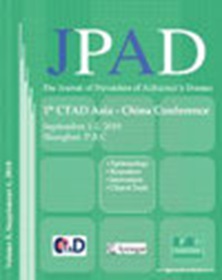抗淀粉样蛋白β治疗阿尔茨海默病患者淀粉样蛋白相关成像异常的检测和处理
IF 7.8
3区 医学
Q1 CLINICAL NEUROLOGY
引用次数: 29
摘要
淀粉样蛋白相关成像异常(ARIA)是阿尔茨海默病抗淀粉样蛋白β(Aβ)治疗试验中报告的不良事件。这篇综述总结了关于ARIA的现有文献,包括巴匹纽珠单抗、甘特单抗、多纳单抗、lecanemab和aducanumab研究,涉及潜在风险因素、检测和管理。ARIA的病理生理学尚不清楚,但它可能与抗体与脑实质和血管系统中积聚的Aβ结合有关,导致血管壁完整性丧失,并增加向周围组织的渗漏。放射学上,ARIA-E被确定为脑实质中的血管源性水肿或软脑膜/脑沟中的脑沟渗出,而ARIA-H是表现为微出血或浅表含铁血黄素沉着的含铁血铁蛋白沉积。ARIA在大多数情况下往往是短暂的和无症状的,通常发生在治疗过程的早期,在治疗后期风险降低。ARIA射线照相检查结果后,可获得的持续给药数据有限;因此,如果发生ARIA,应继续谨慎治疗并定期监测。临床试验已经实施了管理方法,如暂时停止治疗,直到ARIA的症状或放射学体征得到解决或永久停止治疗。ARIA在很大程度上可以在没有伴随治疗的情况下解决,并且没有关于ARIA潜在治疗方法的系统数据。鉴于抗Aβ疗法的可用性,ARIA监测现在将在常规临床实践中实施。临床试验中使用的简单磁共振成像序列可能足以有效检测病例。提高临床医生和放射科医生对ARIA的认识和教育至关重要。本文章由计算机程序翻译,如有差异,请以英文原文为准。
Detection and Management of Amyloid-Related Imaging Abnormalities in Patients with Alzheimer’s Disease Treated with Anti-Amyloid Beta Therapy
Amyloid-related imaging abnormalities (ARIA) are adverse events reported in Alzheimer’s disease trials of anti-amyloid beta (Aβ) therapies. This review summarizes the existing literature on ARIA, including bapineuzumab, gantenerumab, donanemab, lecanemab, and aducanumab studies, with regard to potential risk factors, detection, and management. The pathophysiology of ARIA is unclear, but it may be related to binding of antibodies to accumulated Aβ in both the cerebral parenchyma and vasculature, resulting in loss of vessel wall integrity and increased leakage into surrounding tissues. Radiographically, ARIA-E is identified as vasogenic edema in the brain parenchyma or sulcal effusions in the leptomeninges/ sulci, while ARIA-H is hemosiderin deposits presenting as microhemorrhages or superficial siderosis. ARIA tends to be transient and asymptomatic in most cases, typically occurring early in the course of treatment, with the risk decreasing later in treatment. Limited data are available on continued dosing following radiographic findings of ARIA; hence, in the event of ARIA, treatment should be continued with caution and regular monitoring. Clinical trials have implemented management approaches such as temporary suspension of treatment until symptoms or radiographic signs of ARIA have resolved or permanent discontinuation of treatment. ARIA largely resolves without concomitant treatment, and there are no systematic data on potential treatments for ARIA. Given the availability of an anti-Aβ therapy, ARIA monitoring will now be implemented in routine clinical practice. The simple magnetic resonance imaging sequences used in clinical trials are likely sufficient for effective detection of cases. Increased awareness and education of ARIA among clinicians and radiologists is vital.
求助全文
通过发布文献求助,成功后即可免费获取论文全文。
去求助
来源期刊

Jpad-Journal of Prevention of Alzheimers Disease
CLINICAL NEUROLOGY-
自引率
7.80%
发文量
85
期刊介绍:
The JPAD « Journal of Prevention of Alzheimer’Disease » will publish reviews, original research articles and short reports to improve our knowledge in the field of Alzheimer prevention including : neurosciences, biomarkers, imaging, epidemiology, public health, physical cognitive exercise, nutrition, risk and protective factors, drug development, trials design, and heath economic outcomes.
JPAD will publish also the meeting abstracts from Clinical Trial on Alzheimer Disease (CTAD) and will be distributed both in paper and online version worldwide.
 求助内容:
求助内容: 应助结果提醒方式:
应助结果提醒方式:


